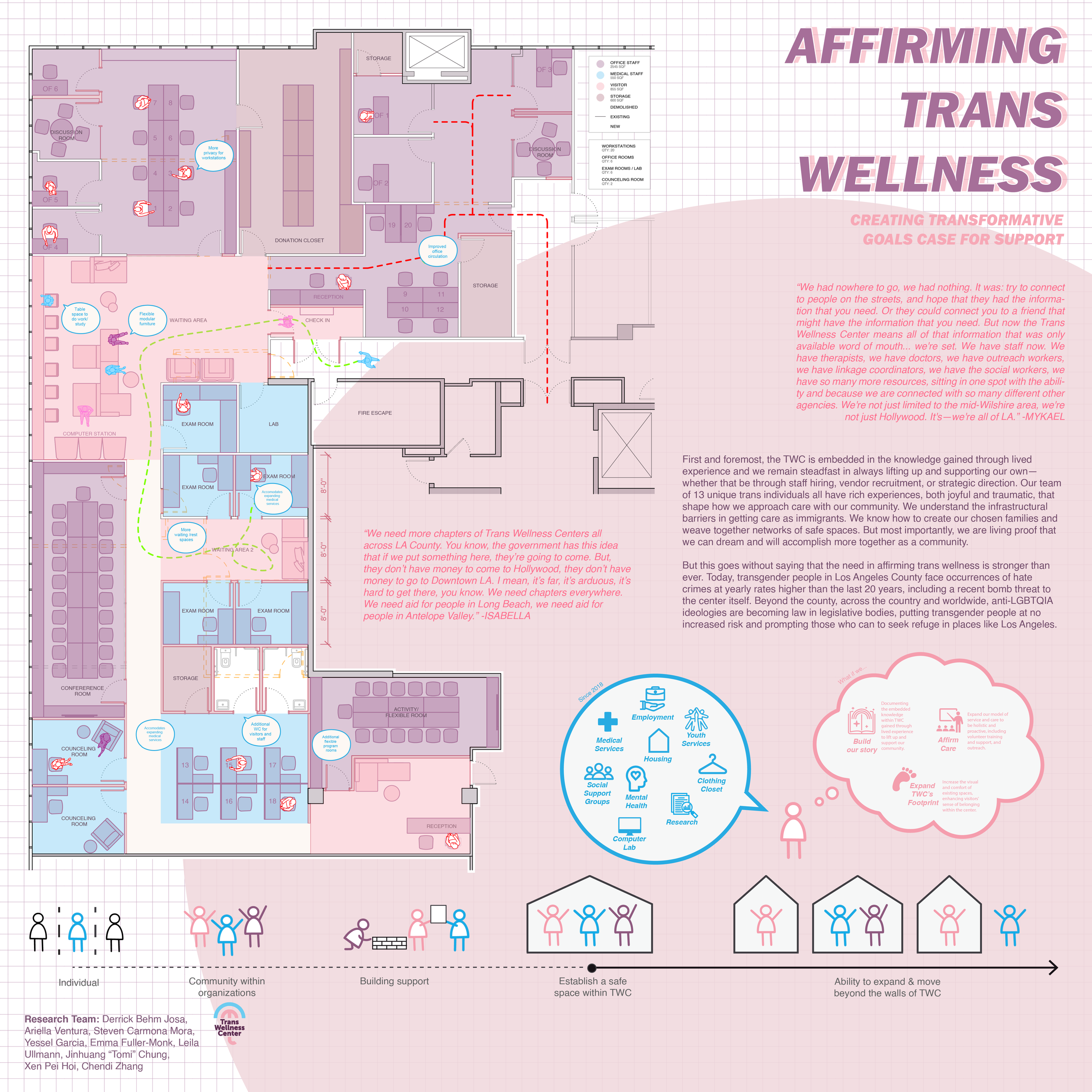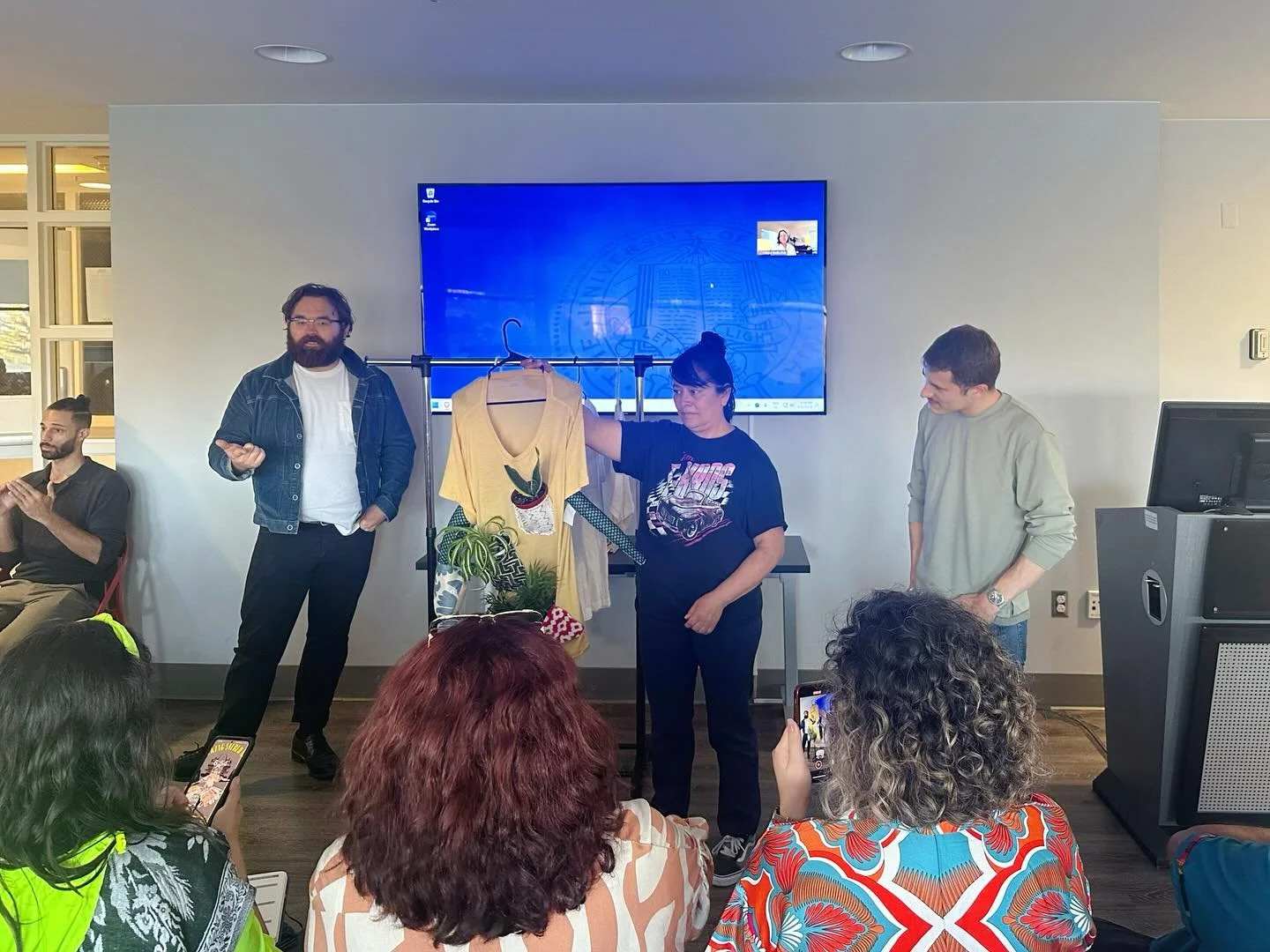Spring Quarter 2024
Instructors Collaborators: Dana Cuff, Gustavo Leclerc, Claire Nelischer, Gus Wendel, Maite Zubiaurre
Community Collaborators: Maya Vision, Heart of Los Angeles, Trans Wellness Center
Students: UHI 2023-24 Cohort.
What does it mean to intervene? For many scholars, this would mean making a discursive intervention in a body of literature. But how are scholars to engage not only with the production of knowledge, but also the site of that production and, moreover, when this site is not in the academy or in an archive, but is “in the field”? In the 2024 Urban Humanities Spring Capstone, we think through these questions by doing. That is to say, we developed and executed projects that are at once scholarly and practical, at once projects in their own right and self-reflexive means of thought. These projects are situated not only in an abstract site of scholarly investigation, but also our home—Los Angeles—bringing all of our positionality and personal investment to bear on the projects.
In the fourth and final course of the Urban Humanities core curriculum we returned to Westlake/MacArthur Park in Los Angeles. Students developed localized, collaborative, interdisciplinary projects that are meant to provide engaged, scholarly interventions around the entwined themes of “(im)mobilities” and “spatial justice” within the context of the Westlake/MacArthur Park neighborhood. The end result extends and deepens students’ lines of inquiry established during the academic year through public-facing projects instigated through the Urban Humanities. The projects draw on the methods we have explored in the urban humanities thus far: thick mapping, filmic sensing, engaged public art. Finally, the course is future oriented. This is to say that questions of the projective and the speculative take center stage and shape not only the desired outcomes of the various projects, but the very process of how we think through and develop the projects.
Codex Westlake: Stories on Red and Black
Course Number: ARCH&UD 289- section 11
Instructors: Gustavo Leclerc, Maite Zubiaurre
Community Collaborator: Maya Vision
Students: Sarp Tanrıdağ, Nidia Bautista, Senna Hanner-Zhang, Jacqueline Vela, Ben Maries, Gabriela Cruz, and Richard Kirk
Capstone Description: In this capstone course, students explored an alternative form of thinking and understanding history and art history based in pictorial representation and visual narratives. Traditional Western-based forms of recording and (re)presenting cultural and art history has been by privileging written language. Pre-Columbian cultures, such as the Aztecs, Mixtecs, and Mayans created complex pictorial records in red and black of significant historical events in the forms of folding books called Codices. This visual and pictorial sensibility can still be noticed in what Octavio Paz called “the will to form” in Mexican culture in general and Indigenous culture in particular. This visual sensibility can also be noticed in the visual, graphic, and spatial displays in indigenous immigrant communities in Los Angeles. Students worked with indigenous immigrants to collect their immigration stories and produce/design a “contemporary Codex” that reflects the pictorial narrative traditions of Indigenous people.
Team #1: “Donde queda el ombligo jamas se olvida” / “Where the navel is, you never forget”
By Sarp Tanrıdağ, Nidia Bautista, Senna Hanner-Zhang, Jacqueline Vela
Team #2: An Abstracted Mayan Codex of Edgar Chaj’s Migration Story
By Ben Maries, Gabriela Cruz, and Richard Kirk
Sidewalking: Designing Pathways with Youth in the City
Course Number: ARCH&UD 289- section 10
Instructors: Dana Cuff, Claire Nelischer
Community Collaborator: Heart of Los Angeles
Students: Alexa Vaughn, Julie Wong, Nils Jepson, Max Kielman, Peter TzuYuan Cheng, Sarah Zureiqat
Capstone Description: In this capstone, students explored the potential of public realm design to advance spatial justice by developing a series of artistic, place-responsive, and actionable interventions to support youth mobility and public space equity in Westlake. Extending from cityLAB's ongoing research and engagement around youth travel and public realm design in Westlake, this project centered the experiences and ideas of young Angelenos aged 11-15 and harnessed the projective potential of design to envision interventions to transform their sidewalk infrastructures. Throughout, UHI students worked closely with our community-based partner organization, Heart of Los Angeles. The project was structured to elevate the voices of young pedestrians in Westlake, who are experts about their own sidewalks. First, through a series of participatory design workshops, walking tours, and feedback sessions, HOLA youth formulated and advocated for their own ideas to improve neighborhood sidewalks, with UHI students as their audience. Next, UHI students gave shape to these ideas through creative design strategies and amplified these ideas through strategic narrative approaches. Throughout, UHI students learned about approaches to youth-centered, community-based, participatory design research that draw from urban humanities practices, and reflect on the relationships between university-city, researcher-participant, and practitioner-community.
Student team: Alexa Vaughn, Julie Wong, Nils Jepson, Max Kielman, Peter TzuYuan Cheng, Sarah Zureiqat
Description: Our final UHI capstone project seeks to memorialize the everyday journeys of HOLA youth – and obstacles they face on those journeys – from their schools to their afterschool program at HOLA Bryson. Specifically, the youth told us they felt the cracked sidewalk outside of HOLA represented their “abandonment” by the City of LA. We brainstormed projects that would call attention to this “abandonment” while reasserting the youths’ inherent agency – in light of Henri Lefevbre’s “Right to the City” – as active makers and stakeholders in their city.
Our intervention was three-fold: 1) create a street-facing mobile art gallery where youth could display their art projects for the community to view, 2) “mend” the sidewalk cracks with clay-cast mosaic art molded and created by the youth themselves, and 3) use temporary chalk-paint and stencils with messages selected by the youth to make a mark and reclaim a sense of belonging on the sidewalk. Our project culminated in a final event where the youth interacted with all three interventions: they placed their mosaics in the sidewalk cracks they were cast from, spray-chalk stenciled their messages, and hung their wishes and hopes for LA on handmade origami pieces in the art gallery.



Queer Space Studio: Queering the public realm for intersectional lives and livelihoods
Course Number: URBN 298
Instructors: Gus Wendel
Community Collaborator: Trans Wellness Center
Students: Derrick Behm Josa, Ariella Ventura, Steven Carmona Mora, Yessel Garcia, Emma Fuller-Monk, Leila Ullmann, Jinhuang “Tomi” Chung, Xen Pei Hoi, Chendi Zhang
Capstone Description: This capstone investigated issues of (im)mobilities in Westlake-MacArthur Park through an explicitly queer lens, that is to say, a lens that challenged fixed social categories and heteronormative spatial histories. To do this, the capstone blended methods developed through queer theory with methods we have learned in urban humanities. Working with the Trans Wellness Center (TWC), a local nonprofit that provides comprehensive resources and services for transgender and non-binary people, students learned about and documented the work of the TWC, its relationship to the neighborhood, and the socio-spatial issues facing the TWC and its clients. Guided by the TWC, students developed projects that elevate the histories and experiences of queer, trans, and/or non-binary -identified people in the neighborhood, and laid bare unforeseen implications for public health and safety, urban planning and design, and public memory.
Research Team: Derrick Behm Josa, Ariella Ventura, Steven Carmona Mora, Yessel Garcia, Emma Fuller-Monk, Leila Ullmann, Jinhuang “Tomi” Chung, Xen Pei Hoi, Chendi Zhang
Community Partner: Mariana Marroquin
Deliverable #1: Case for Support
Deliverable #2: Office Redesign
Deliverable #3: StoryMap







